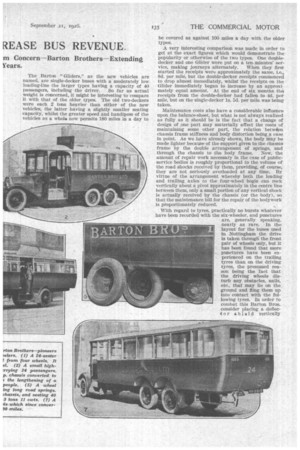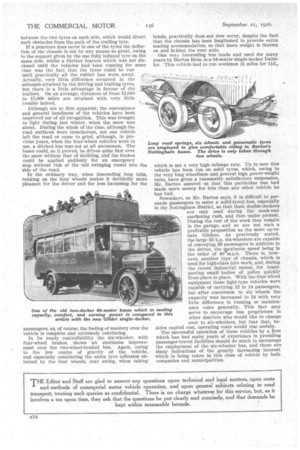HOW SIX-WHEELERS I] REASE BUS REVENUE,
Page 50

Page 51

Page 52

If you've noticed an error in this article please click here to report it so we can fix it.
The Experiences of a Well-known Notti over T m Concern—Barton Brothers--Extending Years.
VERXBODY in Nottingham is familiar with the
I 'A signs B.B.B. (standing for Barton Brothers, Beeston)on the red buses which have been a prominent feature of the district for many years. The fact that a concern such as this has, during the past two years, turned over to ,six-wheelers in place of the old fourwheelers definitely indicates that there is no lack of enterprise on the part of those conducting the road passenger transport of the country and that they do not wait upon the goods carrier to prove the value of any development. To use an expression of Mr. Barton, Sear., they have not been able to find any one feature in the six-wheeler which is bad, all the comments from passengers, drivers and conductors and, finally, in the auditors reports being distinctly favourable.
At the outset we may divide the discussion into four groups—(1) first cost, (2) maintenance cost, (3) convenience and general handiness and (4) passengercarrying capacity, the first two and the last, of course, being very closely interconnected and having an essential bearing upon the profit-earning capabilities of the vehicles. This matter is one which is very difficult in the Nottingham district, as the average fare per passenger-mile is round about a halfpenny, which, of course, is very small when compared with the present-day general railway fare scale of JO. per mile.
With regard to first cost, it might be mentioned that the low loading-line adopted and the long support given to the chassis permits a lighter form of construction for the body as a whole to be employed, which in turn has an important bearing upon tyre wear and petrol consumption. In addition to this, owing to the greater support given by the second axle, the body length can be increased without running the risk of overloading the rear tyres," and the passenger capacity is, in consequence, increased proportionately. Actually Messrs. Barton Brothers have discovered that 33?, per cent, more passengers can be carried at less cost than with a vehicle of the same type, but having four wheels instead of six. 5 The majority of the chassis used by this concern is 35 h.p. Lancias, on which originally the tyre equipment was two 49-in. by 8-in. giant pneumatics, but, on conversion, four 32-in. by 6-in. tyres were used, and they actually cost less than the 40-in. tyres already referred to. The tyre mileage after the conversion increased on an average by 5 per cent., so that a double saving has been effected. at
the same time allowing a larger margin of profit to be obtained, because of the provision of an extra passenger capacity. Taking the whole of their services into consideration, Messrs. Barton Bros. find that the petrol bill per mile run is now slightly less, the original consumption figures having varied between one gallon per 11 miles and one gallon per 14 miles, whereas now the figures are one gallon per 12 miles to one gallon per 15 miles, according to the character of service for which the bus is used. The Barton "Gliders," as the new vehicles are named, are single-decker buses with a moderately low loading-line the larger types having a capacity of 40 passengers, including the driver. So far as actual weight is concerned„ it might be interesting to compare it with that of the older types. The old two-deckers were each 2 tons heavier than either of the new vehicles, the latter having a slightly smaller seating capacity, whilst the greater speed and handipess of the vehicles as a whole now permits 180 miles in a day to
be covered as against 100 miles a day with the older types.
A very interesting comparison was made in order to get at the exact figures which would demonstrate the
popularity or otherwise of the two types. One doubledecker and one Glider were put on a ten minutes' service, making journeys alternately. When they first started the receipts were approximately the same, i.e„ 8d. per mile, but the double-decker receipts commenced to drop almost immediately, whilst the receipts on the Glider immediately began to increase by an approxi: mately equal amount. At the end of six months tie) receipts from the double-decker had fallen to 4th per mile, but on the single-decker is. 5d. per mile was being taken.
Maintenance costs also have a considerable influence upon the balance-sheet, but what is not always realized as fully, as it should be is the fact that a change of design of one part may materially affect the costs of maintaining some other part, the relation between chassis frame stiffness and body distortion being a case in point. As we have already shown, the body may be made lighter because of the support given to the chassis frame by the double arrangement of springs, and through the chassis to the body frame. Now, the amount of repair work necessary in the case of publicservice bodies is roughly proportional to the volume of the road shocks received by them, providing, of course, they are not seriously overloaded at any time. By virtue of the arrangement whereby both the leading and trailing axles to the four-wheel bogie can rock vertically about a pivot approximately in the centre line between them, only a small portion of any vertical shock is actually received by the chassis (or the body), so that the maintenance bill for the repair of the bodywork is proportionately reduced.
With regard to tyres, practically no bursts whatever have been recorded with the six-wheeler, and punctures are, generally speaking, nearly as rare. In the layout for the buses used in Nottingham the drive is taken through the front pair of wheels only, but it has been found that more punctures have been experienced on the trailing tyres than on the driving tyres, the presumed reason being the 'fact that the driving wheels disturb any obstacles, nails, etc., that may lie on the ground and fling them up into contact with the following tyres. In order to combat this Barton Bros. consider placing a deflector ghi el d vertically
between the two tyres on each side, which would divert such obstacles from the path of the trailing tyre.
If a puncture does occur in one of the tyres the deflection of the chassis is not by any means so great, owing to the support given by the one fully inflated tyre on the same side, whilst a further feature which was not disclosed until the vehicles had been running for some time was the fact that the tyres could be run until practically all the rubber has worn away. Actually, very little difference occurred in the mileages attained by the driving and trailing tyres, but there is a little advantage in favour of the trailers. On an average, distances of from 12,000 to 15,000 miles are attained with very little trouble indeed.
Although not at first apparent, the convenience and general handiness of the vehicles have been improved out of all recognition. This was brought to light during last winter, when the snow was about. During the whole of the time, although the road surfaces were treacherous, not one vehicle left the road or came to grief, although, in previous years, when the four-wheel vehicles were in use, a ditched bus was not at all uncommon. The buses could, so it proved, be driven quite fast over the snow without fear of skidding, and the brakes could be applied suddenly for an emergency stop without risk of the tail swinging round into Side of the road.
In the ordinary way, when descending long hills, braking on the four wheels makes it decidedly more pleasant for the driver and far less harassing for the the passengers, as, of course, the feeling of mastery over the vehicle is complete and extremely convincing.
In its ready controllability the six-wheeler, with four-wheel brakes, shows an enormous improvement over the two-wheel-braked bus. Again, owing to the low centre of gravity of the vehicle, and especially considering the extra tyre adhesion obtained by the four wheels, rear swing, when taking bends, practically does mot now occur, despite the fact that the chassis has been lengthened to provide extra seating accommodation, so that more weight is thrown on and behind the rear axle, One very interesting bus made and used for many years by Barton Bros. is a 64-seater single-decker Daimler. • This vehicle had to run workmen 4i miles for lid., which is not a very high mileage rate. Up to now this vehicle has been run on solid tyres, which, owing to the very long wheelbase and general high power-weight ratio, have given a reasonably satisfactory suspension. Mr. Barton assured us that this particular bus had made more money for him than any other vehicle he has had.
Nowadays, so Mr. Barton says, it is difficult to persuade passengers to enter a solid-tyred bus, especially in the Nottingham district, so that their double-deckers are only used during the week-end marketing rush, and then under protest. During the rest of the week they remain in the garage, and so are not such a profitable proposition as the more up-todate Gliders. As previously stated, the large 35 li.p. six-wheelers are capable of conveying 39 passengers in addition to the driver, the iDaximum speed being in the order of 40'm.p.h. There is, however, another type of chassis, which is used for high-class hire work, and, during the recent industrial unrest, for transporting small bodies of police quickly from place to place. With the four-wheel equipment these light-type vehicles were capable of carrying 12 to 14 passengers,• but after conversion to six wheels the capacity was increased to 24 with very little difference in running or maintenance costs generally. This fact may serve to encourage bus proprietors in other districts who would like to change over to six-wheelers, but fear that, besides capital cost, operating costs would rise unduly.
The successful operation of these vehicles by a firm Which has had many years of experience in providing passenger-travel facilities should do much to encourage the employment of the six-wheeler bus, and there are iiany indications of the greatly increasing interest which is being taken in this doss of vehicle by both companies and municipalities.




































































































